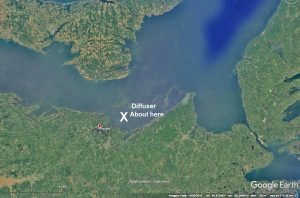UPDATE, JAN 28, 2020 2020
The Mill’s days as a polluter of the air and the water effectively came to a close this month – at least for now.
View related items (search for “Northern Pulp”, “The Mill”) In the News from Dec 15 to Dec 31, 2019 here, and more recent items here.
================================================

The diffuser for the new treatment system would be about here
Click on image to enlarge (from Google Earth)
Fishers in both Nova Scotia and PEI are concerned about impacts on lobster and other fisheries
Few would argue that the effluent treatment system for Pictou Pulp and Paper Mill represents a phenomenally shameful case of recent (and still ongoing) environmental racism in Nova Scotia.
In 1864, land was set aside for the aboriginal community that became known as Pictou Landing First Nation. A hundred years later, Scott Maritimes announced plans to build a mill at Abercrombie Point. The pulp mill promised hundreds of jobs in a rural community that had seen better days. But what to do with 25 million gallons of toxic waste water, the daily byproduct of the pulping process, was a problem.
The solution was to set up a treatment lagoon for effluent on the reserve. Boat Harbour, once a fertile hunting and fishing ground, was turned into a waste site with a toxic cocktail of zinc, cadmium, mercury, dioxins, furans and hydrocarbons.
“It was a place that was completely destroyed and ruined by pollution,” said Jonathan Beadle, who lives in the First Nation community. “When it became polluted as fast as it did, a whole generation of people were completely lost.”
Promises to decrease the adverse effects of the waste water and close the treatment facility have repeatedly fallen through. Then last year, an effluent leak in the pipeline near Indian Cross Point sparked a blockade, kick-starting dormant talks between the government and the band. – The toxic sites of Nova Scotia racism Chronicle Herald, Apr 25, 2015
On April 17, 2015, legislation was introduced to close the Boat Harbour Effluent Treatment by January 2020.
By 2020, the treatment facility will stop receiving wastewater from the mill. Planning for the remediation of Boat Harbour is already underway, and some parts of the estuary could be treated earlier to test different technologies. Press Release, Apr 17, 2015
In the fall of 2017, a little over 2 years from the Jan 2020 deadline for closing the Boat Harbour facility, news of the revised treatment plan began to appear; it would involve an “improved treatment” with the treated effluent released into the Northumberland Strait about 10 km offshore. This has been met with vehement opposition from commercial fishers from both Nova Scotia and PEI.
As it stands in early 2018, there are basically two positions:
(i) the mill survives only if it can treat the wastes with a completely closed loop, land-based system (fishers and others);
(ii) no pipe, no mill (Northern Pulp)
and no one quite knows where it is headed.
Not to mention, ongoing issues with the smokestack emissions, and less than stellar harvesting decisions by Northern Pulp who in the summer of 2016 decided to clearcut a treasured viewscape in the Wentworth Valley.
There’s lots more to this story of course.
Some links:
Dirty Dealing: Northern Pulp Mill and the province are set to roll the dice with Boat Harbour’s replacement, but a cleaner alternative exists
By Linda Pannozzo in the Halifax Examiner, Nov 22, 2017. Comprehensive examination of the options for managing the effluent from the Northern Pulp mill.
Clearcutting our losses
Joan Baxter in The Coast, Oct 5, 2017. “The long history of Nova Scotia sacrificing its forests to big pulp, and why it has to end.”
The Pulp Pollution Primer
by Delores Broten and Jay Ritchlin on watershedsentinel.ca Oct 15, 2012
